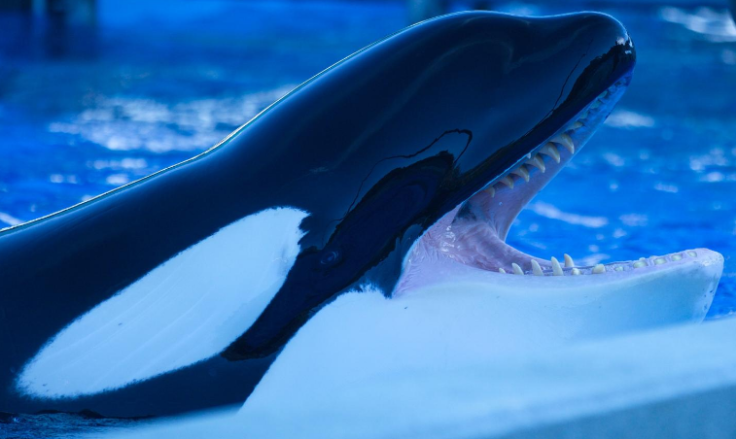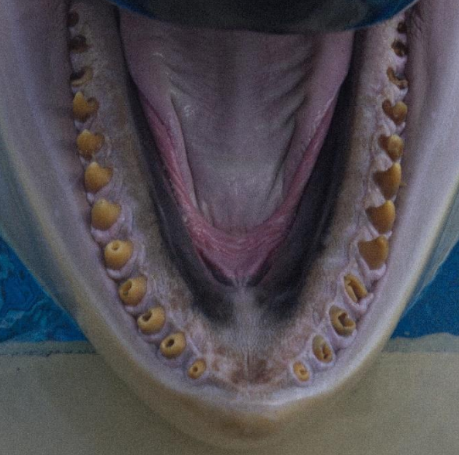Study: Captive Orcas Biting Steel Gates, Suffer Massive Tooth Damage

Orcas in captivity bite on steel tanks so hard that they damage their teeth and suffer toothaches that “cause misery,” a team of international researchers found.
Experts looked at 29 orcas held in the U.S. and Spain owned by one company. They found every single one of mammals had damaged teeth.
Orcas have 48 large teeth, and although the mammals are bigger and stronger than humans, toothaches are likely no less painful or weakening than it is for people.
“Given how big the root of an orca's tooth is and that orca have a nervous system similar to ours, these injuries must be extremely painful,” said co-author Dr. Ingrid Visser, a scientist in New Zealand in a statement.
Researchers found more than 65 percent of the orcas examined suffered from moderate to extreme tooth wear in their lower jaws. About 24 percent of the orcas were found to have “major” to “extreme” mandibular coronal tooth wear, the study said, with coronal wear and wear at or below the gum line “highly correlated.”
Study author and former orca trainer at SeaWorld, Prof. John Jett from Stetson University in Florida, said the damage is due to animals’ chewing of concrete and steel surfaces while captive.
“The vast majority of wild orcas exhibit very little tooth damage,” Jett told International Business Times. “In captivity, the source of damage is chewing and chomping on hard tank surfaces because they are bored. The literature also suggests that mammals may also engage in oral stereotypies because of gastric upset and because of chronic stress.”
Dr. Jeff Ventre, another author of the study and a former SeaWorld orca trainer who is now a medical doctor, said he saw orcas breaking their teeth on steel gates while jaw popping.
“We have personally found teeth fragments on the bottom of Shamu Stadium in Orlando from jaw popping at each other,” Ventre told IBT. Shamu Stadium is in the SeaWorld park in Florida.

The dental damages found on orcas were so bad that they could be identified by specific fractures tooth wear alone, similar to how forensic pathologists identify deceased humans.
“One of the worst cases we observed in our study was Tilikum, the focus of the documentary Blackfish,” said Jett about the orca who recently died. “His teeth were in very poor condition, with no viable teeth in his mandible. He is an animal that Dr. Ventre and I observed chewing on concrete and steel tank surfaces, and we both participated in the drilling of his teeth."

Drilling Teeth
More than half of the orcas studied, 61 percent, had seen a dentist to have their teeth drilled, a process called "modified pulpotomy."
Jet said he always found drilling procedures “very difficult to watch.”
“This is obviously painful as the whales would often vocalize, shudder and sink or swim away from the procedure,” Jett said.
During the procedure, a hole is drilled into the tooth to remove the soft pulpy tissue inside. However, unlike humans, the hole is not filled or capped. Instead the hollow space is left open for the rest of the orca’s life and requires daily flushing with chemicals to keep the teeth empty of food and bacteria that could lead to infections.
“When their teeth wear out or are broken, missing or bored out, the hollow core of the tooth is exposed and it provides a perfect environment for food and debris to collect,” Jett said.
A tooth that is drilled gets severely weakened and could see fractures if any other trauma occurs. Researchers found 60 percent of the second and third teeth of the animals’ lower jaws were broken, which is likely associated with the drilling procedure.
Scientists found dental damage began early in an orca’s captive life. Researchers said the dental problems of the captive orcas raise serious concerns for the animals.
“In general, the dental health of wild orcas is much better than captive killer whales,” Ventre told IBT.
Since the orcas need daily irrigations, the mammals would be labeled as poor candidates if companies considered a full release into the wild.
The findings were published the journal Archives of Oral Biology.
© Copyright IBTimes 2024. All rights reserved.





















